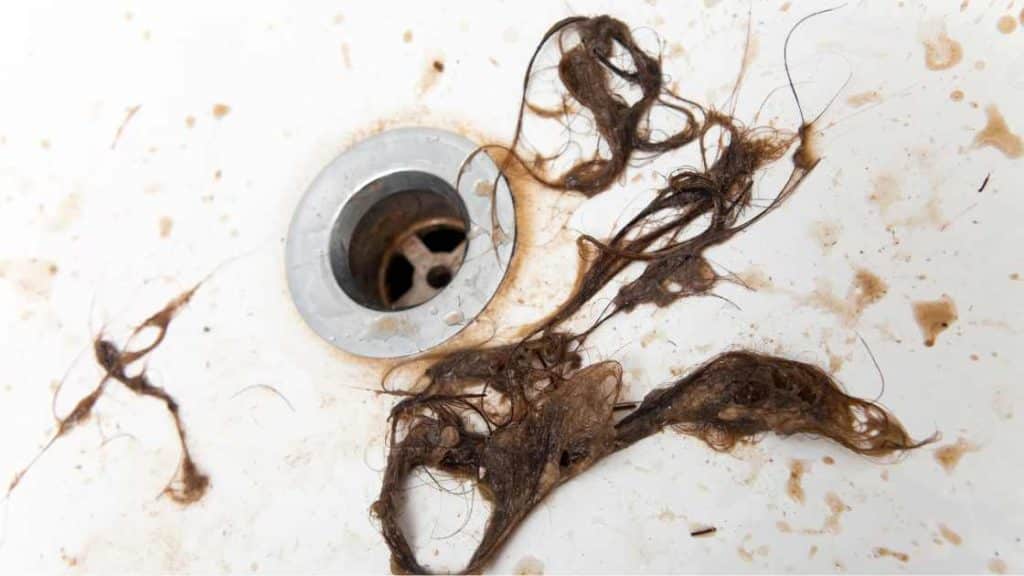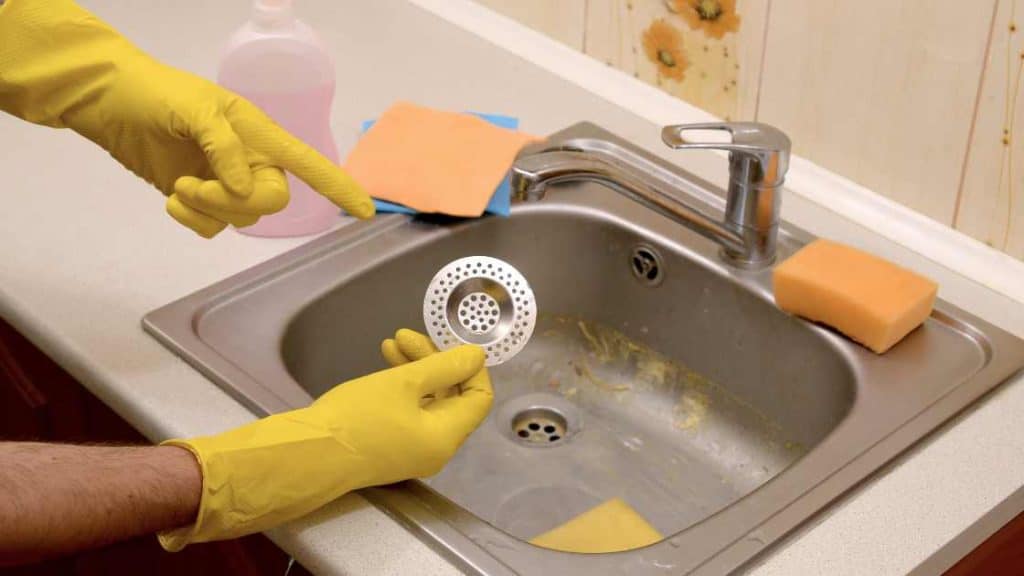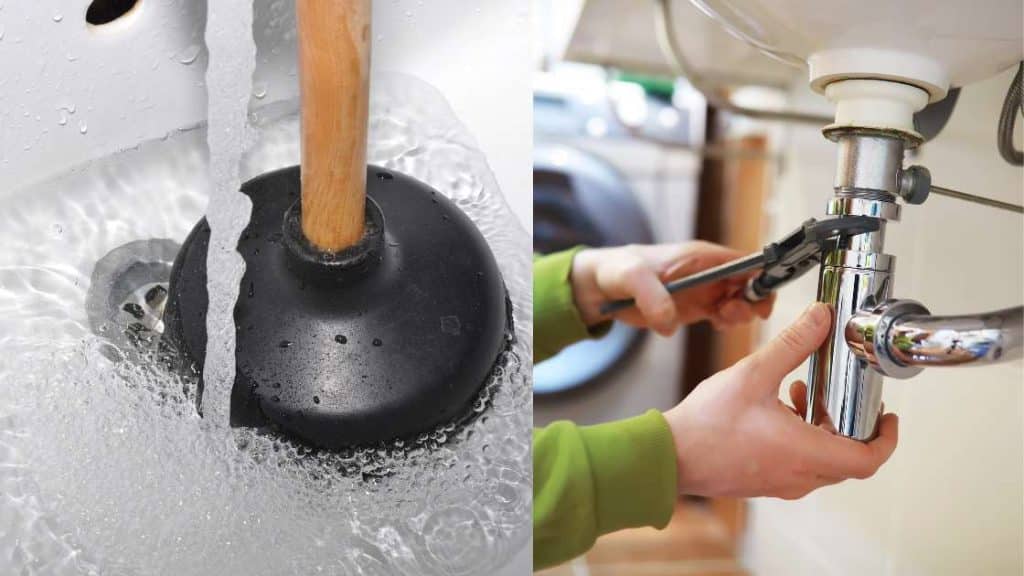To clean hair from a sink drain, use a combination of baking soda, vinegar, and hot water. Follow with a plunger or a drain snake to remove any remaining clogs.
Clogged sink drains can be a hassle, particularly when they’re caused by accumulated hair. In the bathroom, hair is a common culprit, creating blockages that slow down water drainage and potentially lead to plumbing problems.
Timely maintenance and regular cleaning can prevent these issues, ensuring your sink remains fully functional. Wondering how to clean hair from sink drain? Follow these steps for an effective solution.

Homeowners and renters alike often seek effective methods for removing hair from their sink drains to avoid costly repairs. Knowing the right techniques for this task is essential for maintaining clear and clean pipes, saving you time and money on professional plumbing services.
Simple household items can often provide a solution, offering a DIY approach to household upkeep that’s both efficient and cost-effective.
Introduction To Hair Blockages
Sink drains often fall victim to hair blockages, a common but frustrating issue. While washing, strands of hair can slip into the sink. Over time, these strands can build up and create a clog.
Understanding and tackling hair blockages is essential to maintain smooth, clog-free drains. This guide will help you handle the pesky problem of hair buildup in your sink drain.
The Problem Of Hair In Sink Drains
Every time you brush or wash your hair, you’re likely shedding some strands. These strands, although fine, can create major clogs.
They tend to bind with grease and other sticky substances in the drain pipes, leading to significant blockages if not addressed promptly.
The Impact Of Hair Blockages On Plumbing

Hair blockages can lead to slower drainage, standing water, and in severe cases, complete blockages. Such clogs strain the plumbing system, potentially causing leaks or burst pipes.
Regularly removing hair from drains prevents expensive damage and keeps water flowing smoothly.
Identifying A Clogged Sink Drain
A clogged sink drain can turn a daily routine into a frustrating challenge. Recognizing the early signs of a blockage is key to avoiding a full-blown clog.
A hair-clogged drain is a common bathroom nemesis, disrupting water flow and potentially leading to plumbing damage. Let’s decode the signals that suggest a battle with hair buildup is imminent.
Signs That You Have A Hair-clogged Drain
Slow Water Drainage: The most obvious sign of a hair-clogged drain is water taking longer to drain after a shower or brush cleaning.
Gurgling Sounds: Unusual noises from the drain may be whispers of distress from your pipes, indicating a blockage.
Water Pooling: When the sink fills up during normal use, there’s a good chance hair is the culprit.
Unpleasant Odors: A hair clog often traps soap and organic debris, creating a breeding ground for odor-causing bacteria.
When To Handle It Yourself Vs. Calling A Professional
- DIY If: The clog is minor, use a plunger or a plumber’s snake.
- Professional Help: Persistent issues, water backups, or if uncertain, contact a plumber.
Preventive Measures To Avoid Hair Clogs

Keeping your sink free from hair clogs starts with simple steps. You can save time and money with habits that stop clogs before they form. Learn the best ways to prevent hair from blocking your drains.
Using Drain Protectors And Catchers
Drain protectors act like a barrier for your sink, catching hair before it slips down the drain. They come in various materials like metal or silicone and fit right over your sink’s opening. Here’s how to choose and use them:
- Select a size that matches your sink’s diameter for a snug fit.
- Choose a style that complements your bathroom’s design.
- Simple installation—just place it over the opening of the drain.
- Clear it out regularly to ensure a smooth flow of water.
By catching hair strands, these handy tools keep plumbing clear and reduce the need for harsh chemical cleaners.
Regular Maintenance Habits
Adopting regular maintenance habits can greatly reduce hair buildup in your sink drain. Integrating these practices will keep your pipes in top condition:
- Weekly rinsing with hot water flushes away any stray hairs.
- Use baking soda and vinegar monthly for a natural clean.
- Remove and clean your drain stopper frequently.
- Run water during and after shaving to clear debris.
By sticking to a schedule, you’ll minimize the risk of hair-related clogs. Your pipes will thank you for taking these proactive steps!
Diy Techniques For Hair Removal
Hair blockages in the sink drain can cause slow water flow. A DIY approach can save time and money. Let’s Inspect some easy and effective methods to remove hair from the sink drain.
Manual Extraction Methods
Removing hair manually is a straightforward way. It’s simple and cost-effective.
- Use rubber gloves to protect your hands.
- Gather tools such as tweezers or a wire hanger.
- Unbend the hanger to create a small hook.
- Insert the hook into the drain.
- Twist and pull to catch the hair.
- Clean the tool after each use.
Repeat the process until most hair is out. Always be gentle to avoid damaging the pipes.
Natural Drain Cleaning Solutions

Natural solutions are safe for drains and the environment. They help break down hair.
- Boil water and pour it down the drain to loosen the clog.
- Mix baking soda and vinegar for a chemical reaction.
- Wait for 15 minutes as the solution works.
- Flush the drain with more hot water.
This method can be part of regular maintenance to prevent future blockages.
Chemical Drain Cleaners: Pros And Cons
Unwanted hair in your sink drain can spell trouble. Chemical drain cleaners offer a powerful solution to this common problem. These cleaners can dissolve stubborn clogs quickly. But they also come with risks worth considering.
Choosing The Right Chemical Drain Cleaner
Not all drain cleaners are equal. Some cleaners work well for hair, while others target grease or food. To get the best results:
- Check the label to make sure it’s designed for hair clogs.
- Opt for gel cleaners that stick to blockages longer.
- Consider enzyme-based cleaners for a gentler option.
Safety Precautions And Environmental Considerations
Your safety is crucial. Chemical cleaners can be harsh. Protect yourself:
- Wear gloves and eye protection.
- Ensure the room is well-ventilated.
- Follow the instructions on the product label.
Think of the planet. These cleaners can affect the environment. Remember:
- Avoid overuse to minimize chemical exposure.
- Inspect eco-friendly alternatives.
- Dispose of containers properly.
Plunging And Snaking A Clogged Sink

Dealing with a clogged sink can be a nuisance, especially when hair is the culprit. Before you call a plumber, you might want to try plunging and snaking to clear the blockage. These DIY methods can save you time and money.
Step-by-step Guide To Plunging
Facing a slow-draining or stopped sink? Plunge it! It’s simple. Follow these steps to clear the clog:
- Fill the sink with enough water to cover the plunger’s cup.
- Place the plunger firmly over the drain.
- Pump the plunger up and down vigorously.
- Do this for about 20-30 seconds then pull it off.
- Check if the water drains quickly.
- Repeat if necessary.
For double sinks: Cover one drain to direct the force to the clog.
How To Properly Use A Drain Snake
When plunging doesn’t work, a drain snake is your next best tool. It’s easy to use:
- Insert the end of the snake into the drain.
- Turn the handle to feed the snake deeper.
- When you feel resistance, you’ve hit the clog.
- Twist the snake to catch the debris.
- Slowly pull out the snake.
- Clean the end and repeat if needed.
Remember: Gentle twisting can prevent pipe damage.
High-tech Methods: Hydro-jetting And Others
Tangled clumps of hair can turn a sink drain into a stubborn clog, but fear not! Beyond the classic plunger or plumber’s snake, innovative high-tech methods like hydro-jetting provide powerful solutions.
These modern techniques use advanced technology to blast away blockages and ensure your drains flow freely.
Exploring Hydro-jetting Services
Hydro-jetting is like pressure washing for your pipes. Professionals use a high-pressure water stream to obliterate hair clogs deep within your drain. The intense force not only clears the hair but also removes accumulated grease and soap scum.
- Pressure ranges from 1,500 to 4,000 psi.
- Safe on pipes, when a skilled technician performs the service.
- Eco-friendly as it uses water only, with no harsh chemicals.
The Role Of Technology In Unclogging Drains
Advances in tech offer novel ways to maintain clear drains. Cameras now allow us to peek inside pipes, identifying the cause of clogs. Motorized drain augers or electric snakes, cut through hair and debris easily.
| Tool | Function | Advantage |
|---|---|---|
| Drain Cameras | Visual inspection | Precision in locating clogs |
| Electric Snakes | Dislodging clogs | Powerful, less manual effort |
| Hydro-Jet | Cleaning pipes | Thorough, deep clean |
Professional Help: When And How To Hire A Plumber
Battling with a clogged sink can be a daunting task. Sometimes, the hair and gunk buildup is too stubborn for a DIY approach.
That’s where professional help steps in to save the day. Here’s when to call a plumber and how to pick the best one for the job.
Determining The Need For Professional Assistance
Sink drains clogged with hair can lead to worse issues like water damage. Call a plumber if:
- Home remedies fail, after multiple attempts.
- Water backflows frequently, indicating a deeper problem.
- Foul smells persist a sign of potential pipe decay.
If the blockage persists or gets worse, professional services are necessary. Do not wait for small issues to turn into big and expensive ones.
Selecting The Right Plumbing Services
Choosing the right plumber is vital for effective service. Consider these steps:
- Look for a licensed plumber with good reviews.
- Ask neighbors or friends for recommendations.
- Compare rates but don’t compromise on quality.
- Ensure they offer a service guarantee.
| Checklist for Hiring a Plumber | Why It’s Important |
|---|---|
| Licensed and Insured | For quality work and safety. |
| Experience with Hair Clogs | Shows expertise in your issue. |
| Clear Pricing Structure | Prevents hidden charges. |
| Positive Customer Feedback | Ensures reliability. |
Remember, a professional plumber should provide a clear plan. This includes explaining the process and offering long-term solutions. Choosing the right plumber today can prevent future clogs.
Repairing Damage Caused By Hair Blockages

Hair blockages in sink drains can lead to significant plumbing damage. Over time, accumulation can cause pipes to crack or leak. It’s essential to quickly address these issues to maintain a functional sink system.
Assessing the Extent of Plumbing Damage
Assessing The Extent Of Plumbing Damage
To understand the repair needs, inspect the drain for visible signs of damage. Look for leaks, slow drainage, and odd noises. If damage is found, document it for further evaluation.
Options for Repair and Replacement
Options For Repair And Replacement
Different scenarios call for essential repair methods. Below are effective solutions:
- Chemical Cleaners: These dissolve hair but can be harsh on pipes.
- Drain Snakes: A physical tool that removes hair without chemicals.
- Plumber’s Service: For severe cases, professional help ensures a proper fix.
If pipes are damaged:
- Remove the affected section.
- Replace it with new piping.
- Ensure seals are watertight.
Regular maintenance is the best prevention. Clear drains monthly to avoid blockages.
Summarizing Best Practices
Our journey through unclogging hair from sink drains ends here. Let’s recap best practices to keep our sinks flowing freely.
Recap Of Effective Cleaning Techniques
- Use pliers or tweezers to remove visible hair.
- Apply baking soda followed by vinegar for a natural clean.
- Try a plumber’s snake for deeper clogs.
- Chemical cleaners can dissolve hair (use as a last resort).
- Popular DIY: Mix salt, baking soda, and cream of tartar.
The Importance Of Ongoing Drain Health
Maintaining a hair-free drain is key to avoiding bigger plumbing issues later on. Here’s how to keep drains healthy:
- Use drain covers to catch hair before it enters the drain.
- Regularly remove accumulated hair from these covers.
- Weekly flushes with hot water can keep oils and grime at bay.
- Bi-monthly natural cleaners help prevent build-up.
- Professional inspection once a year safeguards against unexpected clogs.
These simple steps ensure your sink stays clean and functional.
Frequently Asked Questions On How To Clean Hair From Sink Drain
What Causes Hair Clogs In Sink Drains?
Hair clogs occur when strands of hair combine with soap scum, grease, and other debris. Over time, this mixture accumulates and solidifies, leading to blockages that prevent water from draining smoothly.
How Can You Prevent Hair From Clogging The Sink?
Installing a drain protector or a hair catcher is the best way to prevent hair clogs. Regularly cleaning the protector and avoiding disposing of large hair clumps in the sink also helps reduce blockage risks.
Can Baking Soda And Vinegar Clear Hair From Drains?
Yes, baking soda and vinegar can help clear hair clogs. Pour a cup of baking soda followed by a cup of vinegar into the drain, wait 15 minutes, and then flush with hot water to dislodge the clog.
How Often Should You Clean Sink Drains To Prevent Hair Build-up?
To prevent hair build-up, clean sink drains at least once a month. If you have heavy bathroom traffic or someone with long hair, you might need to clean it more frequently.
What is the fastest way to get hair out of a drain?
The quickest method to clear hair from a drain is using a drain snake or a hair clog removal tool, which can easily hook and pull out the trapped hair. Pouring a mixture of hot water, baking soda, and vinegar down the drain can help dissolve and flush away hair buildup, providing a swift solution to the problem.
Does Harpic dissolve hair?
Harpic, a household cleaning product, is primarily designed for toilet bowl cleaning and disinfection. While it is effective in removing stains and killing germs, it is not specifically formulated to dissolve hair, and other products designed for unclogging pipes or drains may be more suitable for addressing hair-related issues.
What chemical melts hair?
The chemical commonly known to dissolve or melt hair is sodium hydroxide, which is a strong alkaline substance often found in hair relaxers and depilatory creams. Caution should be exercised when using such products, as they can cause skin and eye irritation if not handled properly.
Conclusion
Dealing with a clogged sink doesn’t have to be a nightmare. Armed with these tips, removing hair from your sink drain becomes a breeze. Regular maintenance, the right tools, and a bit of elbow grease keep your plumbing free-flowing. Remember, preventing hair build-up is simpler than fixing a blockage, so take action early and keep your drains clear and functional.

